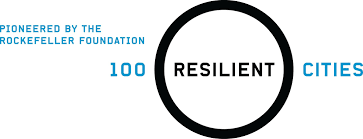Apply now to join our next cohort of Community Science Fellows and Community Leads!

Photo courtesy of 100 Resilient Cities
To develop a comprehensive written report on the City of Atlanta’s greenhouse gas inventories that can provide analysis of the data to be used to support policy decisions to reduce greenhouse gas (GHG) emissions, as well as to provide updates to the public on the status of the City in working to achieve its emissions reductions targets.
Saikawa and her student received an exhaust spreadsheet from the City of Atlanta. Based on this data, they analyzed the two different years – 2013 and 2015 – that they sent. They compared differences between those two years, and then got the other data from the Environmental Protection Agency (EPA) website where they had greenhouse gas (GHG) emissions by source by the US. They also got national level data to compare how that’s different from Atlanta. Although they looked at the equity component (i.e. income level), they didn’t actually integrate this into the summary sheet at the end.
The emissions data Saikawa received was from City of Atlanta. Otherwise, the income level and national level data was from the EPA. Their time was mainly spent cleaning up the exhaust spreadsheet and making the figures.
The team met in person very infrequently. In the beginning, when they initially met, they were hoping to create the spreadsheet so that it could be submitted elsewhere. There was a lot more to the original scope that they had to pare down because of staff upheaval at the City of Atlanta. Saikawa’s student spent about 30 hours or about a month’s worth of work time on this project. Saikawa herself spent about 10 hours total which included a couple of meetings and reviewing her student’s work.
From the City side, Megan O’Neil spent about 10-15 hours while Kate Taber spent about 10-20 hours. Another colleague who left the city midway through this project also spent some time that is unaccounted for. Their time was spent on scope adjustment.
Through this project, Saikawa and her student developed a greenhouse gas inventory summary sheet for the City of Atlanta.
This project was beneficial to the City of Atlanta since it helped them get back on track with doing more regular greenhouse gas emissions inventories. By having this resource and being able to make it publicly available and internally available will help them to focus on certain programming. Mitigating climate change in the City of Atlanta, especially how it relates to emissions from commercial buildings were assumed not to have any impacts. So this has helped to dispel a lot of notions as to what the effects of emissions are for the city.
Saikawa found the involvement of herself and her student highly useful for her research and teaching since she used this dataset in her class. One of her students developed a video as to how Atlanta could reduce emissions, perhaps another useful tool for the city. For students, Saikawa says that being involved in such community science projects as this “…is a great exercise to see the data and potential scenarios to how to mitigate [climate change]. [It is]…great to have the data and see real solutions.”
Saikawa says that she would be happy to share the work. She is interested in exploring a common and easily replicable format with Thriving Earth and other cities that have or might be interested in doing greenhouse gas inventories. Specifically, it could be a very nice way for students to be involved from different parts of the country in a similar manner. For instance, when she went to UN climate negotiations, they had a project through Zoom for students to join in.
O’Neil concurs that it would be the type of project that might be scalable through another university and local partnership. City of Atlanta is much better equipped than the greater Atlanta region, so there is an opportunity to share further.
The team noted that the following contributed to the success of the project:
However, there were several key things that the team would do differently if they had the chance to do this project again:
To other teams currently pursuing Thriving Earth Exchange projects and for those anticipating doing a Thriving Earth Exchange project, the team recommends:
Saikawa and her students have developed a lot of useful ways that the City of Atlanta might be able to use the emissions data now and in the future. That information is available to the City of Atlanta and other cities interested.
For the time being, the City of Atlanta will use this GHG inventory summary sheet to help make climate decisions and set a standard for how emissions data should be collected in future years.
See the team’s output below:
City of Atlanta Greenhouse Gas Emissions Inventory Summary Sheet 2019 01 15
The City of Atlanta, GA is known for southern gentility, a world-class music scene–and 21,000 tons of environmental waste. In spite of its charms, the city’s combination of air pollution and atmospheric chemicals makes it the most toxic city in the country. Increasingly, the city is joining the ranks of many cities attempting to address climate change at the local level.
Urban sprawl and the ensuing greater number of cars on the road are affecting the health of Atlanta’s citizens. The City has collected data on emissions for the and completes an annual greenhouse gas inventory but hasn’t yet had a comprehensive written report on its greenhouse gas inventories that can provide analysis of the data collected for the inventory that can be used support policy decisions to reduce greenhouse gas (GHG) emissions, as well as to provide updates to the public on the status of the City in working to achieve its emissions reductions targets. Therefore, Atlanta’s Mayor’s Office of Resilience is focusing its efforts on putting together a comprehensive framework for reporting annually on its greenhouse gas inventories.
Megan O’Neil, Energy Programs Manager, City of Atlanta Mayor’s Office of Resilience with the support of Ruthie Norton, Deputy Director of Sustainability, Mayor’s Office of Resilience, and Cicely Garrett, Deputy Chief Resilience Officer, will serve as the community lead on this project.
Megan O’Neil is the Energy Programs Manager for the City of Atlanta Mayor’s Office of Resilience, focusing on the development and implementation of clean every policies in the Southeast’s leading city for sustainability, most directly through my leadership in Atlanta’s 100% Clean Energy Plan.
Eri Saikawa is an Assistant Professor at the Department of Environmental Sciences at Emory University. She received a Bachelor of Engineering in chemistry and biotechnology at the University of Tokyo, Master of Public Affairs with a concentration in environmental policy and natural resource management at Indiana University, Bloomington, and a Ph.D. from the Science, Technology and Environmental Policy program at Princeton University. She was a Postdoctoral Associate and a Research Scientist at Massachusetts Institute of Technology before she joined Emory University in 2013. Her research is focused on analyzing sources and magnitude of emissions linked to air pollution, ozone depletion, and climate change, as well as the impacts of these emissions on humans and society.

(c) 2024 Thriving Earth Exchange